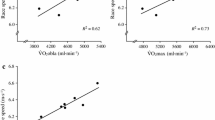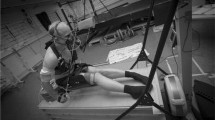Abstract
A supramaximal variable resistance test over varying time intervals was evaluated as an instrument for the assessment of a number of anaerobic parameters, including the accumulated oxygen deficit (AOD). Eight active men [age, 22±1 (SEM 1) years, peak oxygen uptake, 53.1 (SEM 2.1) ml × kg−1 × min−1] completed three randomly ordered all-out sprints of 45-, 60- and 90-s duration. Two incremental pretests consisting of three 5-min stages at power outputs of 45, 135, 225 W and 90, 180, 270 W were performed to establish individual efficiency relationships [r = 0.996 (SEE 1.1) ml × kg−1 × min−1]. These relationships were used to estimate energy demand (millilitres per kilogram of oxygen equivalents in 15-s time intervals) during the supramaximal tests. The AOD for the 45 [47.6 (SEM 1.5) ml × kg−1], 60 [49.0 (SEM 1.8) ml × kg−1] and 90 s [49.6 (SEM 1.7) ml × kg−1] tests were significantly different only for the 45 and 90-s tests. Evaluation of the 90-s test indicated that maximal or nearmaximal (98%) anaerobic energy release was achieved in 60 s, with the AOD beginning to plateau after this time. No significant differences among tests were found for peak power, time to peak power and peak pedalling rate. Differences in mean power, total work and relative power decrement were related to the length of the test. It was concluded that a supramaximal variable resistance test over 60 to 90 s has merit as a test of anaerobic ability as both performance based data and the AOD, a quantitative measure of anaerobic capacity, may be obtained.
Similar content being viewed by others
References
Åstrand PO, Saltin B (1961) Oxygen uptake during the first minutes of heavy muscular exercise. J Appl Physiol 16:971–976
Ayalon A, Inbar O, Bar-Or O (1974) Relationships among measurements of explosive strength and anaerobic power. In: Nelson RC, Morehouse CA (eds) Biomechanic IV. University Press, Baltimore, pp 572–577
Bangsbo J, Michalsik A, Petersen A (1993) Accumulated O2 deficit during intense exercise and muscle characteristics of elite athletes. Int J Sports Med 14:207–213
Bar-Or O (1987) The Wingate anaerobic test; an update on methodology, reliability and validity. Sports Med 4:381–394
Gastin PB (1994) Quantification of anaerobic capacity. Scand J Med Sci Sports 4:91–112
Gastin PB, Lawson DL (1994) Influence of training status on maximal accumulated oxygen deficit during all-out cycle exercise. Eur J Appl Physiol 69:321–330
Gastin P, Lawson D, Hargreaves M, Carey M, Fairweather I (1991) Variable resistance loadings in anaerobic power testing. Int J Sports Med 12:513–518
Gastin PB, Costill DL, Lawson DL, Krzeminski K, McConell GK (1994) Accumulated oxygen deficit during supramaximal all-out and constant intensity exercise. Med Sci Sports Exerc, in press
Gollnick PD, Piehl K, Saltin B (1974). Selective glycogen depletion pattern in human muscle fibers after exercise of varying intensity and at varying pedalling rates. J Physiol (Lond) 241:45–57
Graham KS, McLellan TM (1989) Variability of time to exhaustion and oxygen deficit in supramaximal exercise. Aust J Sci Med Sport 21:11–14
Hermansen L, Medbø JI (1984) The relative significance of aerobic and anaerobic processes during maximal exercise of short duration. Med Sport Sci 17:56–67
Jacobs I, Bar-Or O, Karlsson J, Dotan R, Tesch P, Kaiser P, Inbar O (1982) Changes in muscle metabolites in females with 30-s exhausting exercise. Med Sci Sports Exerc 14:457–460
Karlsson J, Saltin B (1970) Lactate, ATP, and CP in working muscles during exhausting exercise in man. J Appl Physiol 29:598–602
Linnarsson D, Karlsson J, Fagraeus L, Saltin B (1974) Muscle metabolites and oxygen deficit with exercise in hypoxia and hyperoxia. J Appl Physiol 36:399–402
Medbø JI (1991) Quantification of the anaerobic energy release during exercise in man. Thesis, University of Oslo, Norway
Medbø JI, Tabata I (1989) Relative importance of aerobic and anaerobic energy release during short-lasting exhaustive bicycle exercise. J Appl Physiol 67:1881–1886
Medbø JI, Burgers S (1990) Effect of training on the anaerobic capacity. Med Sci Sports Exerc 22:501–507
Medbø JI, Mohn A, Tabata I, Bahr R, Vaage O, Sejersted OM (1988) Anaerobic capacity determined by maximal accumulated O2 deficit. J Appl Physiol 64:50–60
Newsholme EA (1984) Metabolic control and its importance in sprinting and endurance running. Med Sport Sci 17:1–8
Olesen, HL (1992) Accumulated oxygen deficit increases with inclination of uphill running. J App] Physiol 73:1130–1134
Saltin B (1987) The physiological and biochemical basis of aerobic and anaerobic capacities in man: effect of training and range of adaptation. In: Maehlum S, Nilsson S, Renstrom P (eds) An update on sports medicine: proceedings from the 2nd Scandinavian conference on sports medicine. Syntex, Strømmen, pp 16–59
Saltin B (1990) Anaerobic capacity: past, present, and future. In: Taylor AW, Gollnick PD, Green HJ, Ianuzzo CD, Noble EG, Metivier G, Sutton JR (eds) Biochemistry of exercise VII. Human Kinetics, Champaign, Ill, pp 387–412
Scott CB, Roby FB, Lohman TG, Bunt JC (1991) The maximally accumulated oxygen deficit as an indicator of anaerobic capacity. Med Sci Sports Exerc 23:618–624
Serresse O, Lortie G, Bouchard C, Boulay MR (1988) Estimation of the contribution of the various energy systems during maximal work of short duration. Int J Sports Med 9:456–460
Vandewalle H, Peres G, Monod H (1987) Standard anaerobic exercise tests. Sports Med 4:268–289
Weyand PG, Cureton KJ, Conley DS, Higbie EJ (1993) Peak oxygen deficit during one- and two-legged cycling in men and women. Med Sci Sports Exerc 25:584–591
Withers RT, Sherman WM, Clark DG, Esselback PC, Nolan SR, Mackay MH, Brinkman M (1991) Muscle metabolism during 30, 60, and 90 s of maximum cycling on an air-braked ergometer. Eur J Appl Physiol 63:354–362
Withers RT, Van Der Ploeg G, Finn JP (1993) Oxygen deficits incurred during 45, 60, 75 and 90 s of maximal cycling on an air-braked ergometer. Eur J Appl Physiol 67:185–191
Author information
Authors and Affiliations
Rights and permissions
About this article
Cite this article
Gastin, P., Lawson, D. Variable resistance all-out test to generate accumulated oxygen deficit and predict anaerobic capacity. Eur J Appl Physiol 69, 331–336 (1994). https://doi.org/10.1007/BF00392039
Accepted:
Issue Date:
DOI: https://doi.org/10.1007/BF00392039




